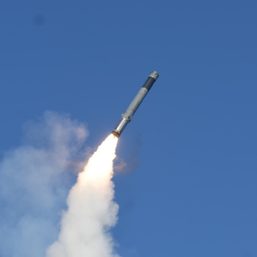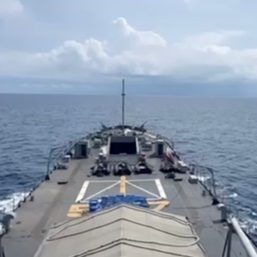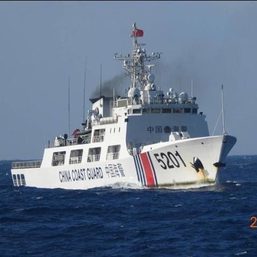SUMMARY
This is AI generated summarization, which may have errors. For context, always refer to the full article.
![[ANALYSIS] The South China Sea: What’s in a name?](https://www.rappler.com/tachyon/2020/07/south-china-sea-august-4-2020.jpg)
I grew up referring to the marginal sea that is part of the Pacific Ocean – encompassing an area from the Karimata and Malacca Straits to the Strait of Taiwan – as the South China Sea. This is what our teachers taught us as grade school students in Sibika at Kultura lessons.
As a child, I had therefore been conditioned to consider that portion of the Pacific Ocean as a sea that belongs to, or at least is associated, with China. To put it simply, it must be part of Chinese territory because of its name.
The identification of a thing, or in this case a place, sends tacit messages to an audience. We tend to concede to the authority of official names. Widespread use of official names in communication effects the creation of a norm.
Acceptance by a greater many of a novel term transforms it. With prevalent use, the character of novelty is lost in favor of normalcy. A truth, in a way, is created – at least for the populace that grows accustomed to the use of the official name.
This is perhaps why former President Benigno Aquino III signed Administrative Order No. 29 into effect. The Order provides that “the maritime areas on the western side of the Philippine archipelago are hereby named as the West Philippine Sea. These areas include the Luzon Sea as well as the waters around, within, and adjacent to the Kalayaan Island Group and Bajo De Masinloc, also known as Scarborough Shoal.”
Attached to the acceptance of an official name are the implications inherent in it. By calling it the West Philippine Sea in communication, we convince correspondents of our belief as a people that we lay claim to the sea, or at least such parts of it that we can lay claim to. (READ: [ANALYSIS] Duterte’s weak grasp of the maritime case on South China Sea)
Section 6 of Administrative Order No. 29 also provides that “the Department of Education (DepEd), the Commission on Higher Education (CHED), and state universities and colleges (SUCs) are directed to issue circulars requiring the use of said official Philippine maps in relevant subjects, researches and instructional materials, such as, among others, text books, instructional materials, and audio-visual presentations.”
By this provision, the Order attempts to propagate and perpetuate, especially among future Filipino generations, an acceptance of, and even an advocacy for, our territorial claims in the West Philippine Sea.
Still, the predominant name in English for the sea that is the subject of this essay is South China Sea. This is a result of its “discovery” by European explorers during the Age of Exploration.
The name ‘South China Sea’ is a vestige of colonial imperium
The Age of Exploration, also called the Age of “Discovery,” is an informal term for the period of history circa 15th to 18th Centuries. It was that time during which the European monarchs, chiefly Portugal and Castile, commissioned various overseas expeditions of discovery.
I used quotation marks to enclose the initial use of the word discovery because it is hardly the case that the Europeans came upon territories that were previously undiscovered. Many of the territories they discovered were already inhabited by civilizations and cultures that they essentially conquered and made their vassals.
In fact, one is hard-pressed to differentiate between discovery and military conquest. Many of the expeditions commissioned by the empires to discover territories were led by conquistadores. These conquerors, with their relatively advanced military technology, laid conquest to the lands and the peoples inhabiting them. In some cases, they virtually eradicated whole civilizations through warfare or the introduction of disease.
This period of discovery led to the rise of colonialism. The subjugated peoples and their lands became the first colonies of the vast empires of Portugal and Castile. These series of conquests culminated in the signing of the Treaty of Tordesillas. The contract essentially split the world in two for the Portuguese and Castilian Empires to appropriate.
Portugal and Castile were the preeminent thalassocracies, sea powers that held their colonial empires together by their naval supremacy. They established the first global trade routes that were the precursors of a globalized economy.
We were taught that the Crown of Castile commissioned the Portuguese explorer Fernao de Magalhaes to find a westward route to the Moluccas. This resulted in the expedition that Magalhaes led, but he did not survive accomplishing the first circumnavigation of the globe. The Crown of Castile commissioned the explorer to search for a new route because the Treaty of Tordesillas reserved the established eastern routes for Portugal.
The expedition, ultimately completed by Spaniard Juan Sebastian Elcano, was important for Castile because the Moluccas were then famed as the Spice Islands, where nutmeg, mace, and cloves could be exclusively found. Spice was then a privilege fit only for royalty and nobility.
A return expedition to the land – mistaken by the first expedition as the Moluccas – upon which Magalhaes’ blood was spilled by the tribes of Mactan, led to the appropriation of an archipelagic colony. The Crown of Castile named those islands Las Islas Filipinas in honor of Philip II of Spain.
The trade routes blazed by explorers like Magalhaes and Elcano connected the colonies to their European masters. By these routes, precious commodities like spice and silk were traded. The importance of trade routes has not diminished since.
The Portuguese explorers of the 16th Century were the first to call the sea subject of this essay the South China Sea. Captains coming from Hindustan (India) saw it as a passage to China and called it Mare da China[5]. It gained greater prominence as a route from Europe to China with growing European interest in Chinese commodities such as silk and tea.
Its name, one cannot deny, is a relic from the age of colonial imperium when great empires ruled over vassal states. It is a remnant of an age when merchant vessels plied maritime routes to carry the produce of colonies to the seats of their masters.
China used to be and remains to be a potential superpower
China was, even then, already an empire in its own right. The first Emperor of a unified China ruled over the Qin Dynasty, some 200 years before Christ[6].
As such, China was a thousand-year empire when it began trade with Maritime Southeast Asia[7]. Maritime Southeast Asia comprises the archipelagic nations of the region – Malaysia, Brunei, Philippines, Singapore, Indonesia, and Timor Leste. (READ: War with China over West PH Sea? Look at Vietnam, Malaysia, Indonesia, says Carpio)
However, unlike Portugal or Castile, China did not resort to conquest of the region. Even its naval expeditions mostly engaged in diplomacy and peaceful trade with the peoples of Maritime Southeast Asia. Proof perhaps of this is that the region is predominantly non-sinicized, except for Singapore and maybe to a lesser extent, Malaysia.
This can only mean that Imperial China historically recognized the sovereignty of the tribes, kingdoms, and sultanates of Maritime Southeast Asia. It is therefore ahistorical for China now to lay claim over its Nine-Dash Line – which covers most, if not all, of the West Philippine Sea. The Nine-Dash Line is the vaguely located demarcation line used initially by the Republic of China (1912–1949) and subsequently by the governments of the Republic of China (ROC/Taiwan) and the People’s Republic of China (PRC), for their claims of the major part of the sea.
The latter is now a potential superpower, arguably with the strongest military in Asia. It has the largest standing army in the world and has a widely recognized nuclear capability. Its naval power is a threat even to the United States, which since the end of the Cold War has been considered to be the only remaining superpower. The latter maintains a presence in Asia and the Pacific, through its navy’s Seventh Fleet, in case of conflict with North Korea in the Korean Peninsula, or with the PRC in the Taiwan Strait or West Philippine Sea.
An economic powerhouse which has just recently overtaken Japan as the second largest economy after the US, the PRC’s economic security is intimately connected to the West Philippine Sea. Those trade routes remain just as important today as they were when it was Imperial Portuguese ships that plied them. No less than one-third of global shipping passes through the West Philippine Sea.
The sea is also a hotbed of natural resources like oil, natural gas, and fisheries. Exploration and eventual exploitation of these resources will tremendously benefit the economy of any claimant state. This is why shared exploration is even being considered.
In its claims against the various actors in the disputes over island and maritime territories covered by its Nine-Dash Line, the PRC has doggedly insisted on bilateral negotiations. Negotiations of the sort will expectedly be in its favor, owing to the skewed power relations it has with relatively weaker states like the Philippines and other Southeast Asian countries. In such talks, the PRC will always be dominant in all the relevant aspects – politics, economics, and military power.
The concept of historic rights is a relic of a bygone era
The PRC bases its claim to the coverage of its Nine-Dash Line on historic rights – that it has historically exercised exclusive control over the waters, islands and resources of the West Philippine Sea.
But the notion of historic rights as a basis for territorial claims is questionable.
In a case brought before the International Court of Justice involving the sovereignty of Indonesia and Malaysia over Pulau Ligitan and Pulau Sipadan, in which our own country lost its Application to Intervene, a Separate Opinion of Judge ad hoc Thomas Franck concluded that:
Accordingly, in light of the clear exercise by the people of North Borneo of their right to self-determination, it cannot matter whether this Court, in any interpretation it might give to any historic instrument or efficacy, sustains or not the Philippines claim to historic title. Modern international law does not recognize the survival of a right of sovereignty based solely on historic title; not, in any event, after an exercise of self-determination conducted in accordance with the requisites of international law, the bona fides of which has received international recognition by the political organs of the United Nations. Against this, historic claims and feudal pre-colonial titles are mere relics of another international legal era, one that ended with the setting of the sun on the age of colonial imperium.
Reliance on historic rights is a vestige of the era during which colonial powers treated colonies as mere property at their disposal. But this is no longer the case in today’s age of self-determination. The simplistic era of “might is right” is over. The international community has renounced war and conquest as a means of political advancement.
Since after the end of the First World War, there has been an international commitment to dismantle colonial empires. No less than the United Nations itself was founded on principles as self-determination and the eradication of the last remnants of colonial imperium. It has as far back as 1961 created the Special Committee on Decolonization to achieve this goal.
It follows that the vestiges of colonial imperium like the notion of historic rights must be abandoned as well. It harkens to that dark period of the Age of Discovery when whole peoples were subjugated or eradicated by conquest.
<h1>China’s historic rights as basis for its claim over its Nine-Dash Line has been ruled invalid</h1>
But even if historic right is granted as a foundation for China’s claims over the islands and waters of the sea subject of this essay, the Permanent Court of Arbitration has nevertheless ruled that there is no evidence that China had historically exercised exclusive control over its waters or their resources. It even traded with the peoples of Maritime SEA as sovereign entities.
In the South China Sea Arbitration rendered on 12 July 2016, the tribunal constituted under Annex VII of the United Nations Convention on the Law of the Sea (UNCLOS) unanimously rendered an Award in favor of the Philippines against the PRC. (READ: U.S. warns China of ‘severe consequences’ if it reclaims Scarborough Shoal)
It must be noted that the PRC has ratified the UNCLOS and is thereby bound by the Convention. It must respect the findings of a tribunal composed under UNCLOS provisions. It has, however, refused to participate in the Arbitration and insists that it is not bound by the Award. It stands firm in its position that bilateral negotiations must be had to resolve the dispute, knowing full-well its leverage as a potential superpower.
This position is dangerous as it is reminiscent of state relations that rest on nothing but power overwhelming. It tempts contempt of international law and the bodies created thereunder to foster peace, consensus and equality. It rattles the saber to advance national interests. It erodes the commitment of nations to the treatment of states as sovereign equals.
It begs the question to Judge Franck: do we suffer another empire on which the sun never sets? – Rappler.com
Gino Leocadio is a law graduate working for the environment department. He believes that a civil servant should be beholden to the people, and not the government that appoints them
Add a comment
How does this make you feel?





There are no comments yet. Add your comment to start the conversation.